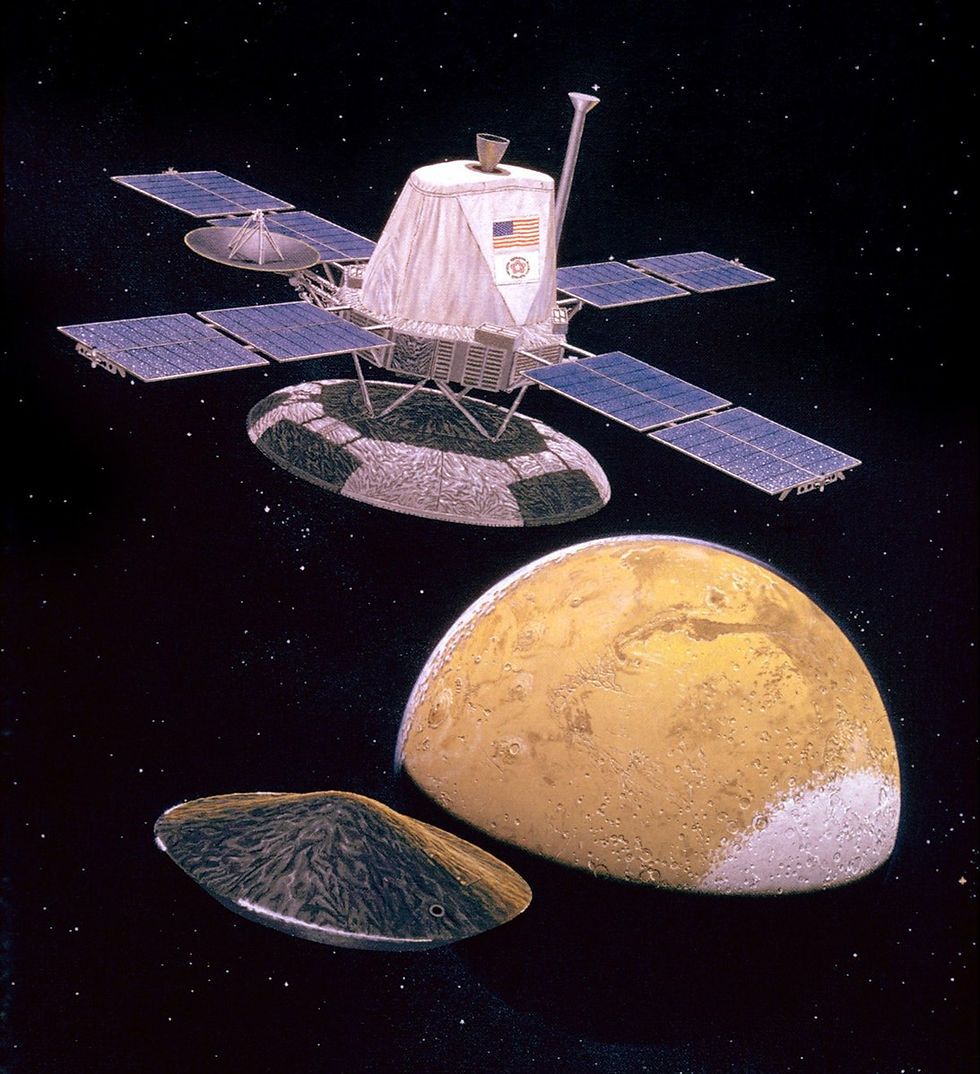NASA's Viking Landers & the Hunt for Alien Life
- Aeryn Avilla

- Jul 20, 2023
- 8 min read
Updated: Feb 17, 2025
In 1965, NASA's Mariner 4 spacecraft became the first artificial object to fly by Mars and transmitted the first photographs of the planet's surface. People on Earth were disappointed when these photographs showed no evidence of extraterrestrial life, an idea popularized by Percival Lowell's theory of canals on Mars. As Mariners 6 and 7 returned images of the planet's surface in the following years, scientists considered the possibility of life existing on Mars millions of years ago. Project Viking aimed to find such evidence.

Viking was the US's first attempt to land on another planet. On December 2, 1971, the Soviet Mars 3 became the first spacecraft to soft-land on Mars, but transmission was interrupted after less than 15 seconds. Viking had these primary objectives:
Take high-resolution images of the Martian surface
Provide data on the composition and structure of Mars's atmosphere and surface
Search for evidence of life
Project Viking had two identical spacecraft each consisting of a lander and an orbiter. The Langley Research Center was responsible for overall mission design and management while the Jet Propulsion Laboratory (JPL) was in charge of the Viking orbiters. The orbiters were based off the Mariner planetary spacecraft with design changes to fit the more advanced Viking mission objectives. They each had an operational lifetime of 120 days in orbit and another 90 days after deploying the landers. Both had octagonal buses approximately 8 feet across (2.4 m) and 10.8 feet high (3.3 m). With their four solar panels extended, they had a diameter of 32 feet (9.7 m). These panels had a combined area of 161 square feet (15 square m). The lowest altitude for these spacecraft was 186 miles (300 km) from the surface.
Although often overshadowed by the landers' achievements and historical firsts, the Viking orbiters culminated in numerous discoveries about the existence of past water on Mars's surface. Photos transmitted showed huge river valleys with evidence of flooding and traveling thousands of miles across the surface.
Viking Orbiter schematic and vehicle. Click for higher resolution. (NASA)
The Viking landers were 10 feet across (3 m), 7 feet tall (2 m), and weighed 1,270 pounds (576 kg) without fuel. They consisted of five basic subsystems:
Lander body: Both landers had hexagonal buses supported by three landing legs 51 inches long (1.3 m). Each leg had a circular footpad 1 foot in diameter (30.5 cm) to reduce the shock of landing. Superficially, they resembled the Surveyor lunar landers.
Two-piece bioshield: The bioshield cap and base formed a pressurized cocoon that sealed the lander and prevented any biological contamination of the spacecraft with Earth bacteria. If the landers detected terrestrial bacteria that hitched a ride to the Martian surface, the entire mission would have been a failure.
Aeroshell: The aeroshell was a flat cone-shaped heat shield containing twelve small reaction control engines to align the lander for entry into Mars's atmosphere and maintain descent speed.
Base cover: The base cover fit between the bioshield cap and the lander and housed the parachute.
Lander subsystems: The lander's subsystems were divided into six categories: communications equipment, data storage, descent engines, guidance and control, landing radars, and power sources.
The landers had operational lifetimes of 90 days and were powered by radioisotope thermoelectric generators.
Viking lander schematic (NASA) and test article used to simulate the performance of the two spacecraft on Mars (National Air and Space Museum). Click for higher resolution
Viking 1 launched onboard a Titan IIIE rocket from Cape Canaveral's Launch Complex 41 on August 20, 1975, and entered Mars orbit on June 19 the following year. The mission used the Viking B spacecraft because prior to launch, Viking A's batteries lost charge and the spacecraft was replaced. The Viking site certification team determined the original landing site had rougher terrain than expected, so the Viking 1 lander landed 560 miles (900 km) northwest on the western slope of Chryse Planitia (the Plains of Gold) on July 20, 1976— the 15th anniversary of the Apollo 11 moon landing. During its six years on the surface, it transmitted thousands of high-resolution images and 300° panoramas of the Chryse Planitia landscape, which included parts of the spacecraft itself. Although its seismometer was inoperable, Viking 1 recorded temperatures ranging from —186°F (—86°C) to —91.4°F (—33°C). The spacecraft collected its first of four soil samples on July 28, and the data of all samples will be discussed later in this post. A faulty command sent from Earth interrupted communications on November 11, 1982 and the Viking 1 lander ceased operation on November 13 after six years. Controllers at JPL attempted to regain contact, but after six and a half months of no success, the first Mars landing mission officially came to an end on May 21, 1983. The lander was retroactively named the Thomas Mutch Memorial Station in honor of the late leader of the Viking imaging team and was photographed on the Martian surface by the Mars Reconnaissance Orbiter in 2006.

The first color image of Mars taken by Viking 1 on July 21, 1976 (NASA)
The Viking 1 orbiter made a close-approach to Mars's moon Phobos in February of 1977 and ceased operating on August 7, 1980, after nearly 1,500 orbits of the planet. But not before causing a bit of trouble. On July 25, 1976, the spacecraft snapped an image of Mount Cydonia, located in the Arabia Terra region on Mars. The resulting image looked a little too familiar for comfort. Dubbed the "Face on Mars", the formation quickly became the subject of speculation on the possibility of artificial structures on Mars and if humans and so-called "Martians" could share a similar origin. Is it possible nearby boulders and hills are remnants of structures erected by a long-forgotten race of intelligent beings? Public speculation did not wane until the Mars Global Surveyor captured a vastly different photo of Mount Cydonia in 2001. The "face" was nothing more than the human tendency to see faces in inanimate objects, a phenomena known as face pareidolia. One could argue mankind flew all the way to Mars in search of extraterrestrial life only to find itself.
Viking 1 on July 25, 1976 Mars Global Surveyor in 2001
Viking 2 launched onboard a Titan IIIE rocket from LC-41 on September 9, 1975 and entered Mars orbit on August 7, 1976. It landed on September 3 at Utopia Planitia near the edge of the polar ice cap with one leg on a rock, tilted 8.5° to the west. This site was chosen due to its proximity to frozen water, i.e., where the chances of finding traces of life where higher than at a site similar to Viking 1's Chryse Planitia. Utopia Planitia was flatter and rockier than Chryse Planitia. The lander lost contact with Earth on April 11, 1980, and in July of 2001 was renamed the Gerald Soffen Memorial Station in honor of the leader of the Viking science team.
The Viking 2 orbiter made a close-approach of Mars's moon Deimos in October of 1977. Due to the lack of significant topographical references at Utopia Planitia, the orbiter was unable to precisely locate the lander. The spacecraft completed just over 706 orbits of the planet before ceasing operations on July 28, 1978 due to battery failure.

Project Viking's primary mission ended on November 15, 1976, shortly before Mars passed behind the sun. In mid-December, when the planet came out from behind the sun, mission controllers reestablished contact with the spacecraft and began Extended Mission operations, which lasted from December of 1976 to May of 1978. This was followed by Continuation Mission operations, lasting from May of 1978 to July of 1979. Between both orbiters, 52,000 images of Mars were taken and 97% of the surface mapped at a resolution of 984 miles (300 m). The landers transmitted more than 4,500 photos to Earth that provided the first up-close looks at the planet's surface.

According to a Project Viking fact sheet published by the Jet Propulsion Laboratory, it was discovered that Martian regolith is a type of iron-rich clay that releases oxygen when wetted. a Changes in the Martian surface also occur extremely slowly, with only a few minor changes happening during the project's six years of surface operations.
The Viking landers also detected nitrogen in Mars's atmosphere, which had not been detected by previous Mariner missions. The greatest concentration of water vapor in the atmosphere is near the edge of the permanent north polar ice cap in the summertime. a Subsurface water, or permafrost, covers much of the planet year-round. The southern ice cap is composed of carbon dioxide. Furthermore, the climate of the northern and southern hemispheres differ due to dust storms and the movement of water vapor in the atmosphere.

A total of seven soil samples were taken by both Viking landers and analyzed by the gas chromatograph and mass spectrometer instruments. The experiments provided no evidence for the presence of organic compounds in the soil of Chryse Planitia and Utopia Planitia that were detectable at the parts-per-billion level. This is actually less than in the lunar regolith samples returned by Apollo astronauts earlier in the decade. a Scientists believe Mars to be self-sterilizing, in which the combination of solar ultraviolet radiation, the dryness of the soil, and the oxidizing nature of the soil prevent the formation of living organisms (NASA). b According to the National Air and Space Museum, Viking's failure to find any evidence of past or present life on Mars led to some scientists to abandon the belief that extraterrestrial life might exist elsewhere in the solar system. c JPL director Bruce Murray expressed dissatisfaction with Project Viking being treated as the "definitive means of ascertaining whether or not life existed on Mars" (NASM)— when no life was found, both scientists involved in the project and the American public were sorely disappointed, if not outraged. As a result, NASA did not return to Mars until 1996 with the Mars Global Surveyor [1].

Despite finding no evidence of past or present life on Mars's surface, Project Viking was an astounding success and has influenced NASA's current approach to searching for traces of life in the solar system. The Mars 2020 mission, better known as Perseverance, is the first mission since Viking to hunt for life directly, this time focusing on evidence of past life on Mars. The Viking landers were limited by the technology of the time, but just because neither detected traces of life in Martian regolith does not mean Mars was unable to have supported life in the past. Only time will tell what groundbreaking discoveries Perseverance, Curiosity, and future Mars landers and rovers will make.
Author's note: Thanks for reading and be sure to like and share this post!
[1] The next American mission to Mars following Viking 2 was actually the Mars Observer in 1992, but contact with the spacecraft was lost prior to orbital insertion.
Bibliography
Anderson, Paul Scott. "Viking Remembered: Celebrating the 40th Anniversary of the First Search for Life on Mars." AmericaSpace. 2016, https://www.americaspace.com/2016/07/19/viking-remembered-celebrating-the-40th-anniversary-of-the-first-search-for-life-on-mars/
Siddiqi, Asif A. "Beyond Earth: A Chronicle of Deep Space Exploration, 1958 — 2016." NASA. 2018, https://www.nasa.gov/sites/default/files/atoms/files/beyond-earth-tagged.pdf
"Viking 1 & 2." NASA Science Mars Exploration. https://mars.nasa.gov/mars-exploration/missions/viking-1-2/ b
"Viking Lander." National Air and Space Museum. https://airandspace.si.edu/collection-objects/lander-mars-viking-proof-test-article/nasm_A19790215000 c
"Viking Mission to Mars." Jet Propulsion Laboratory. 1988, https://mars.nasa.gov/internal_resources/828/ a
"Viking Mission to Mars." NASA Space Science Data Coordinated Archive. https://nssdc.gsfc.nasa.gov/planetary/viking.html


















Comments